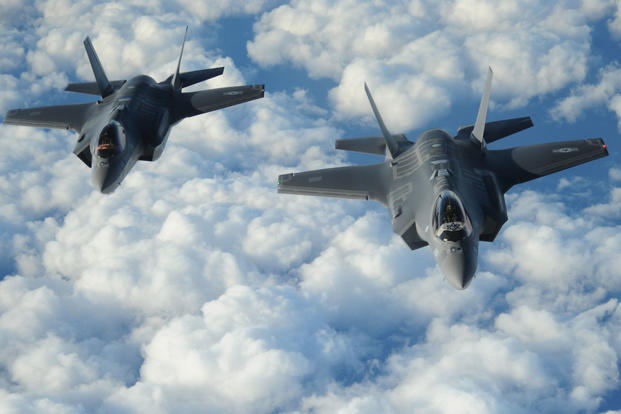The F-35 Joint Strike Fighter has made its combat debut in the Middle East.
Israeli Air Force commander Maj. Gen. Amikam Norkin announced that its F-35 aircraft, known as Adir, "are already operational and flying in operational missions."
"We are the first in the world to use the F-35 in operational activity," Norkin said via the official Israel Defense Forces' Twitter account Tuesday.
Norkin said F-35s had been used in two recent strikes, but it is unclear whether the aircraft supported the missions by providing intelligence, surveillance and reconnaissance or conducted the strikes.
The F-35 has conducted strikes in the Middle East on at least two occasions in recent months, he said.
Related content:
- With Older F-35s 'On Life Support,' Wing Struggles to Train Pilots
- Peeking into the Air Force's F-35 Training Course
- New Air Force Acquisitions Chief Aims to Rid F-35 of Software Glitches
"We have performed the first operational F-35 strike in the world," Norkin told audiences at Israel's international air force commander convention Tuesday. "We attacked twice in the Middle East using the F-35. We are the first in the world to do so."
Earlier this month, Iranian forces "fired 32 rockets, we intercepted 4 of them & the rest fell outside Israeli territory," Norkin tweeted, referring to a counterattack in the Golan Heights.
Israel responded by attacking multiple Iranian weapons and logistics sites in Syria. "In our response attack, more than 100 ground-to-air missiles were fired at our planes," he said.
Israel declared initial operating capability of its Lockheed Martin-made F-35I in December. Middle Eastern outlets have said the fifth-generation stealth aircraft has likely made flights before for reconnaissance missions over or near Syrian territory, but those reports are unconfirmed.
In February, Israel launched a counterattack on Iranian targets in Syria in response to an Iranian drone's intrusion into its airspace. During the mission, an Israeli F-16 was targeted and crash landed back in Israeli territory.
Critics at the time wondered why the F-35 wasn't used, since the aircraft would have been better able to evade enemy radar. But pilots and former members of the Israeli Air Force said use of the F-35 would have been risky so early in its operational lifespan.
"If they thought that the targets were so strategically important, I'm sure they'd consider using them. But they weren't. So why risk use of the F-35s at such an early point in their operational maturity?" retired Israeli Air Force Brig. Gen. Abraham Assael told Defense News at the time.
Israel in August signed a new contract with Lockheed for its next batch of 17 aircraft, following two previous contracts for 33 aircraft.
IAF officials have expressed interest in buying up to 30 additional aircraft.
Israel's declaration comes a few short months after the U.S. Marine Corps F-35B short takeoff/vertical landing fighter embarked on its first deployment aboard the amphibious assault ship Wasp for patrols in the Pacific.
The U.S. Air Force similarly deployed its F-35A variant to Asia in November.
-- Oriana Pawlyk can be reached at oriana.pawlyk@military.com. Follow her on Twitter at @Oriana0214.










